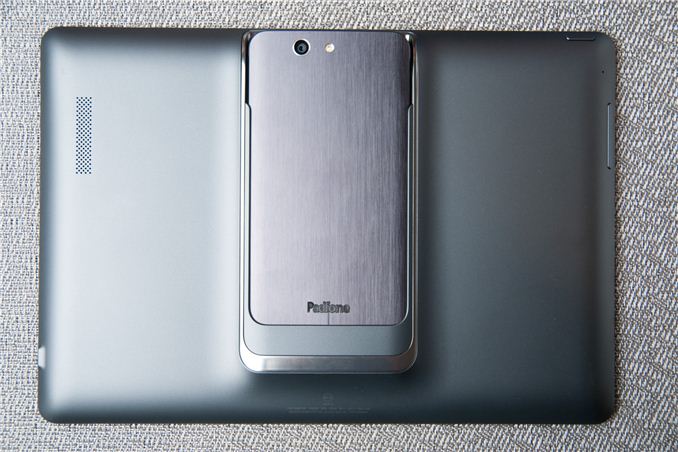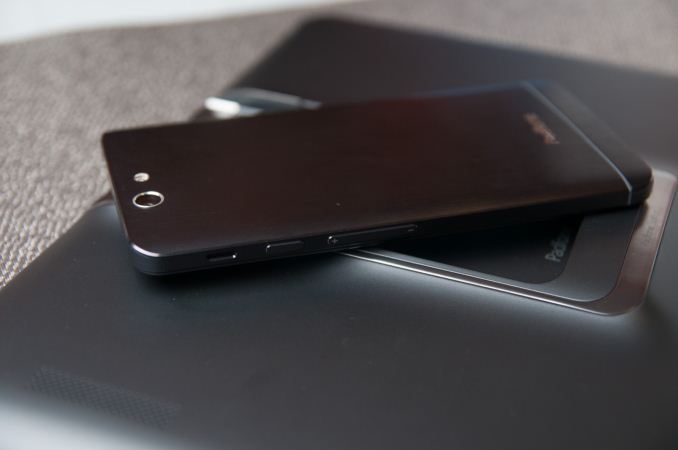Hands on with the new ASUS Padfone Infinity
by Brian Klug on September 17, 2013 9:00 AM EST- Posted in
- Smartphones
- Asus
- Mobile
- Padfone
- Tablets
- Android 4.2
- Snapdragon 800

For a while now, ASUS has been pushing form factor boundaries in the mobile space, with dockables and other 2-in-one platforms that once seemed radical but really started making sense after a while. I've been itching to get to try one such category for a while now, the Padfone, which combines 10.1-inch tablet form factor display and battery with a 5-inch form factor smartphone device. Compute resides in the smartphone form factor device, but when docked into the Padfone station, you bring everything over with you including connectivity, media, and the platform itself. ASUS has been selling the Padfone line for a while now, and we just recently received the new Padfone Infinity based on Snapdragon 800 to play around with.
The Padfone Infinity is based on a Snapdragon 800 platform with the 2.2 GHz Krait 400 clocks inside, and 450 MHz Adreno 330 GPU. There's also 2 GB of LPDDR3 alongside. I'll save the rest of the spec listing for the table, but the Padfone Infinity is absolutely bleeding edge in terms of both its camera, displays on both the smartphone and station, and SoC inside. I've only been playing with the Padfone for a short time, but UI is very smooth in both modes, and the transition between tablet and phone operation is very fast.
| ASUS Padfone Infinity | |
| SoC |
Qualcomm Snapdragon 800 (MSM8974) 4x Krait 400 2.2 GHz, Adreno 330 GPU |
| Display |
5-inch 1080p IPS (PadFone) 10.1-ich 1920x1200 IPS (PadFone Station) |
| RAM | 2 GB LPDDR3 RAM |
| WiFi | 802.11a/b/g/n/ac + BT 4.0 |
| Storage |
16/32 GB Internal, microSD slot (up to 64 GB), 50 GB ASUS WebStorage |
| I/O |
3.5mm headphone, nanoSIM, myDP (USB 2.0 host+device, 1080p video out) |
| OS | Android 4.2.2 |
| Battery |
2400 mAh (PadFone) 5000 mAh (PadFone Station) |
| Size / Mass |
143.5 x 72.8 x 8.9mm, 145 grams (PadFone) 264.6 x 181.6 x 10.6mm, 532 grams (PadFone station) |
| Camera |
2 MP w/AF, F/2.0 (Front) 13 MP w/AF,LED F/2.0 (Rear) |
| Network |
EDGE/GPRS/GSM: 850/900/1800/1900MHz
UMTS/DC-HSPA+: 850/900/1900/2100MHz
(DL: 42Mbit/s / UL: 5.76Mbit/s)
LTE Cat 4: 800/1800/2600MHz
(DL: 150Mbit/s, UL: 50Mbit/s) |
I've been wanting to take a look at the Padfone line for a long time regardless of the fact that there's no variant yet with USA-appropriate LTE bands. The other side of the Padfone is that US operators seem to be hostile to the form factor for some reason, of course it's an obvious way for consumers to get both tablet and smartphone under a single data plan.
I've been impressed with ASUS hardware build quality since playing with some of the earliest mobile devices, and it has continued to improve. The Padfone Infinity seems to have nailed the insert/eject force for the smartphone module, and the docking station tablet seems to be pretty solid. The industrial design is almost the same as the Padfone Infinity I played with at MWC earlier this year, though the new Padfone infinity adds a diamond cut edge to the rear of the phone to make it less sharp when held in the hand. I was impressed then with the use of metal on the smartphone module and continue to be impressed with both build quality and way that handset feels. I'm buried in smartphones and devices for this refresh period before the holidays, but we're definitely going to take a longer look at the Padfone Infinity.

















34 Comments
View All Comments
fteoath64 - Wednesday, September 18, 2013 - link
Yikes. 14nm ARM chips will kill Intel completely!. It will be TWICE as fast yet consume 20% less power and costing less than half of the intel part. That 14nm Finfet is the holy grail of Arm and that is "game over" for the Atom family even with price drops, no body would want it. Why do you think Intel goes into a "quark" contingency recently ?.Travis Jackson - Wednesday, September 18, 2013 - link
Maybe I'm just being impatient! Remember though, Bay Trail was only just released, and the Windows 8.1 products have yet to hit the shelves. Then there's the issue of Bay Trail not totally optimized for Android yet, which will mean a few weeks of in-house tweaking. Then it'll go to the OEMs, yada, yada, yada...With any luck, we should be seeing Bay Trail-based regular Android tablets (7, 8 & 10 inches) by November if we're lucky. But for a specialty item like the Padfone, I'd expect it to take a lot longer - 3 or 4 months just for a prototype. Even conservatively, 6 months... But yeah, if it's going to take a whole year, then they (Asus) may as well just skip Bay Trail and go with Airmont.
Electromikey - Tuesday, September 17, 2013 - link
Would this work on T-Mobile's HSPA+ network?darkich - Tuesday, September 17, 2013 - link
Gosh this peripherial modular concept will be such an absolute smashing win when the connection goes wireless.Even now it is far and beyond better option in theory, than having two separate devices.
- it SAVES MONEY
- it saves you the trouble of syncing/multiple downloading and data connection bills
Just imagine if Samsung for example, had a docking standard incorporated in their galaxy phones.
You could buy an Galaxy S5 and invest just another 200-300$ in the whole range of high quality Samsung touch display peripherials to pick from.
Tablets as a separate devices would became pointless.
flyingpants1 - Wednesday, September 18, 2013 - link
I don't think so. Constantly unplugging/replugging the phone would be a hassle - the connector would eventually wear out. I find text messaging is much easier on a smaller screen with one hand, whether I'm typing normally or using Swype.It doesn't really save money, either.
As you say, it will be cool when they are wireless, but that won't be until at least 5 years from now. Wireless display is just not great at the moment.
puremind - Tuesday, November 19, 2013 - link
Please post objective comments. It saves money because purchasing two high end devices would cost 60-80% more.You don't have to constantly plug and unplug the phone. The tablet mode takes calls too when you are in stationary mode...
phoenix_rizzen - Tuesday, September 17, 2013 - link
Is there a keyboard dock available for this version?If there's another battery in the keyboard, we'd finally have "all-day mobile computing". :)
Death666Angel - Tuesday, September 17, 2013 - link
Not my cup of tea. I'm not very impressed with the large non-Windows tablets I've used. I end up having to carry around a laptop anyway, so I just switched to a Windows 2-in-1 device (Samsung XE700T1C) and sold my 10.1" tablet. This would not be something for then, especially since the phone has to be inserted without a case (which makes sense), but I never carry around a phone without a case, so there'd be the hassle of removing the case and having to put it somewhere. If there was something like this with a 4.5" phone and a 7", maybe 8" tablet, that would be more interesting to me. As it stands now, I'm gonna use the hell out of my Galaxy Nexus and get a Nexus 7 2013 to go along with it. And maybe at some point I'll get my option above or a good 6.5", 7" phablet.puremind - Tuesday, November 19, 2013 - link
They are contemplating making Windows 8 available on this as well.satai - Tuesday, September 17, 2013 - link
Terribly missing a keyboard dock with other battery and without need to use possibly unsafe bluetooth.